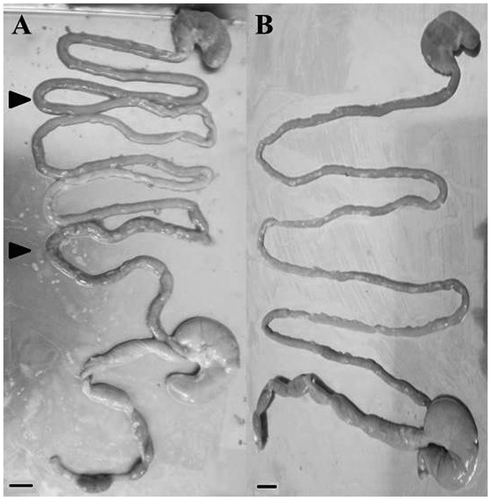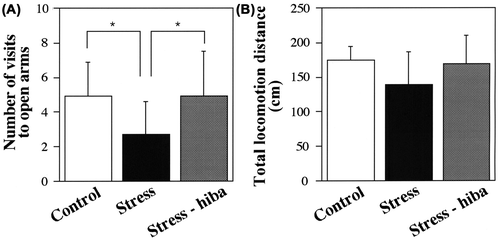Figures & data

Fig. 1. Changes in the physiological variables.
Note: Changes in the quantities of food intake (A) and water intake (B), excretion amount (C), and body weight (D) during the experimental period are shown. All parameters of stressed rats were less than those of both control rats and stress-HEO rats during the experiment [horizontal hatched bars, food: F(2,18) = 40.47, P < 0.001; water: F(2,18) = 58.74, P < 0.001; excretion: F(2,18) = 39.41, P < 0.001; weight: F(2,18) = 31.50, P < 0.001]. Open and closed circles indicate the values of control (n = 12) and stressed rats (n = 10), respectively. Closed squares indicate the values of stress-HEO rats (n = 12). Error bars indicate SD.
![Fig. 1. Changes in the physiological variables.Note: Changes in the quantities of food intake (A) and water intake (B), excretion amount (C), and body weight (D) during the experimental period are shown. All parameters of stressed rats were less than those of both control rats and stress-HEO rats during the experiment [horizontal hatched bars, food: F(2,18) = 40.47, P < 0.001; water: F(2,18) = 58.74, P < 0.001; excretion: F(2,18) = 39.41, P < 0.001; weight: F(2,18) = 31.50, P < 0.001]. Open and closed circles indicate the values of control (n = 12) and stressed rats (n = 10), respectively. Closed squares indicate the values of stress-HEO rats (n = 12). Error bars indicate SD.](/cms/asset/8f9c9e6d-c25f-4b57-ac5c-512eb6c46d23/tbbb_a_918492_f0001_b.gif)
Fig. 2. Ratios of weights of the adrenal glands and thymus relative to the body weight.
Note: (A) Ratios of weights of the adrenal gland of stressed and stress-HEO rats were greater than those of control rats (*P < 0.05, †P < 0.01). No significant difference was observed in the ratio of the weight of the adrenal glands between stress and stress-HEO rats. (B) No significant difference was observed in the ratio of the weight of the thymus among control, stressed, and stress-HEO rats. White, black, and gray columns indicate the percents of control (n = 12), stressed (n = 10), and stress-HEO rats (14 weeks of age, n = 12), respectively. Error bars indicate SD.

Fig. 3. Representative images of gastrointestinal tracts (14 weeks of age).
Note: (A) Gastrointestinal tracts from stressed rats. (B) Gastrointestinal tracts from stress-HEO rats. Intestinal bleeding was observed in stressed rats (arrowhead) but not in stress-HEO rats. Scale bar = 1 cm.

Fig. 4. Behavioral analysis in the elevated plus-maze test.
Note: (A) The number of visits to the open arms during the 10-min period. The number of visits to the open arms by stressed rats was smaller than that of control rats (P < 0.05), and the number of visits to the open arms by stress-HEO rats was recovered to the value of control rats (P < 0.05). (B) The total locomotion distance during the recording period (10 min). No significant difference was observed in the total locomotion distance among stressed, stress-HEO, and control rats. Note that the inhalation of hiba oil by stressed rats may have caused a decrease in the stress level compared with that of stressed rats not treated with the oil. White, black, and gray columns indicate the percents of control (n = 12), stressed (n = 10), and stress-HEO rats (n = 12), respectively. Error bars indicate SD.

